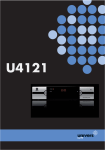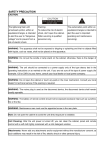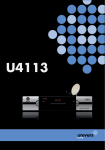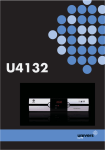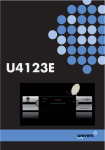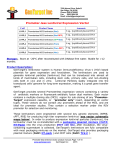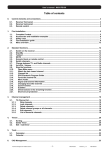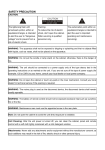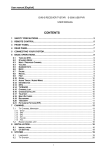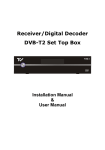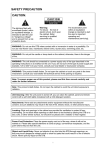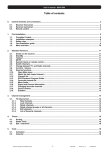Download MAX S21_EN_v1.0.indd
Transcript
MAX S21 The lightning flash with arrowhead symbol, within an equilateral triangle, is intended to alert the user to “dangerous voltage” and to prevent from a risk of electric shock. Warning: To reduce the risk of electric shock, don’t open the cabinet. Refer servicing to qualified personnel only. The exclamation point within an equilateral triangle is intended to alert the user to important operating and maintenance (servicing). Please read the manual carefully before installing the receiver. Caution: Never open the device by yourself. Dangerously high voltages are present inside the unit. Refer servicing to qualified staff only. When installing the receiver, always unplug the receiver from the mains voltage. Unplug the receiver from the mains in case of long periods without operating the receiver (for example, during holidays!). To prevent shock hazard, do not touch the power plug with wet hands. Always unplug the receiver before cleaning it or working on the connections. Do not install the receiver close to strong heat sources, and ensure a good aeration if you plan to install the receiver in a small cabinet. Before you start operating the receiver, make sure that the satellite antenna is properly built up, optimally connected and aligned. The correct place to install the receiver is, of course, near your TV set and any other A/V signal sources (DVD, VCR, CD, game console, etc.). Choose a stable support, in which you can easily lay the necessary connecting cables without stumblingdanger. The receiver should be installed near an easily accessible outlet. Do not install the receiver in a place where it can be reached by liquid spills. Do not put any heavy objects as, for example, a TV-device over the receiver; the receiver could be damaged. DO NOT INSTALL THE RECEIVER: - On an unstable surface - Subject to direct sunlight - In high humidity environment - Outside the receiver’s temperature range (+5°...+40°C) If the receiver is subject to severe temperature changes, it can suffer from water condensation inside. Switch off the receiver in these cases for at least 2 hours before resuming operation. rev 1.0 ENGLISH SAFETY PRECAUTION PAG. 2 QUICK INSTALLATION GUIDE In order to download the complete user’s guide and get more information about receivers, please visit the website http://receivers.ftemaximal.com QUICK INSTALLATION GUIDE STEP 1: CONNECTIONS Follow next steps for the correct installation of this receiver. ENGLISH The remote control transmits a directional infrared beam. Be sure to aim the remote control directly at the infrared sensor of the receiver during operation. If the sensor has been covered or there is a large object between the remote control and the sensor, the sensor will not respond. The sensor may not able to receive the remote signal when it is exposed to direct sunlight or a strong artificial light (flurescent or strobe light). In this case, change the direction of the light or reposition the sensor to avoid direct lighting. rev 1.0 The coaxial cable, with satellite signal, must be connected to the “IF IN” connector. The “TV SCART” connector must be connected to the TV set. Depending on the type of installation, the receiver should be connected and configured following next examples. Example 1 – Basic System PAG. 3 ENGLISH QUICK INSTALLATION GUIDE Example 2 – DISEqC switches Example 3 – Combined with terrestrial STEP 2: BASIC CONFIGURATION OF THE RECEIVER Language: Press [ ] to select languages. The selection of languages include: English, German, French, Spanish, Italian, Portuguese, Turkish, Polish, Russian, Arabic. First Audio: Some channels offer more than one audio language. This function allows you to set the preferred audio language for those channels using [ ]. If a channel offers the same audio language as the “First Audio” you set the system will play this audio language as default. If the channel does not offer this audio language then the system will compare the offered PAG. 4 rev 1.0 IMAGE 1 The receiver includes an installation assistant (Quick Setup) that will help you to setup the different parameters. When the receiver is turned on at first time (IMAGE 1): The receiver is programmed with all the channels of Astra (at position 1 of the DISEqC), Hotbird (at position 2 of the DISEqC), Hispasat (at position 3 of the DISEqC) and Turksat (at position 4 of the DISEqC). If your installation is different to this case, please follow installation steps to search the channels. In order to move through the different options of this menu, ] and [ ] of your remote please use the keys [ control. Note: On there is a short-circuit in the LNB, the receiver will make a reset. Please verify your cables and connections. Once the crossed is solved, the receiver will stop making resents and it will start normally. QUICK INSTALLATION GUIDE languages with the second audio language. The selections of audio languages include: English, German, French, Spanish, Italian, Portuguese, Turkish, Polish, Russian, Arabic. Subtitle Language: Press [ ] to select subtitle languages. The selection of languages include: English, German, French, Spanish, Italian, Portuguese, Turkish, Polish, Russian, Arabic. IMAGE 2 LNB Power: Here you can set the power output to the LNB. If your receiver is connected to the LNB directly then you need to set the LNB Power to “On”. If your receiver is connected to a multi switch (SMATV signal distribution system) then it may be that you don’t need to provide the power to the LNB (IMAGE 2). But since this is depending on the kind of installed distribution system we recommend you to contact your installer or to refer to the user manual of this system to get the correct information. Press [ ] to switch between “On” /”Off”. Satellite List rev 1.0 IMAGE 3 When you enter the “Satellite List” menu you can see a window like the one beside (IMAGE 3): 1. Move through the satellite list using [ ] and mark/ unmark the satellites that you want pressing [OK] 2. Press [Red] button to enter edit satellite menu. You can edit the satellite’s name and its longitude. Once you have edited the satellite, select “Save” option and confirm with [Yellow] button. If you prefer to exit without saving the changes press [Blue] button. 3. Press [Green] button to open the “Add satellite” window. You can edit the satellite’s name and its longitude. Once you have edited the satellite, select “Save” option and confirm with [Yellow] button. If you prefer to exit without saving the changes press [Blue] button. 4. After pressing [Blue] button you will be asked “Are you sure to delete?”. Select “Yes” to delete the marked satellite. Select “No” to cancel the operation. Press [Exit] to save the changes and go to the previous window to continue configuring the antenna. PAG. 5 ENGLISH Second Audio: If the channel has no audio language that corresponds with “First Audio” but with “Second Audio” the system will play the second audio language as default. If no audio language corresponds with the “Second Audio” then the default language of the current channel will be played instead. The selections of audio languages include: English, German, French, Spanish, Italian, Portuguese, Turkish, Polish, Russian, Arabic. QUICK INSTALLATION GUIDE ENGLISH IMAGE 4 IMAGE 5 Single search: You can edit the following items (IMAGE4): 1. Satellite: Press [ ] to switch Satellites or press [OK] to enter satellite list to select directly. 2. In the “FTA Only” item, press [ to select to scan only free channels or even scrambled channels. If you select “Yes” it will scan free channels only. 3. In “Scan Channel” item, press [ ] to select to scan TV + Radio Channels, or just TV channels or just Radio channels. 4. Network Search: If you select this option as “Off”, the receiver will search the selected Satellite. In case you select “On”, the NIT (Network Identification) will be identified and the receiver will automatically search all the TP of this network. 5. In “Scan Mode” item you can select “Auto Scan” to blind scan or “Preset Scan” to scan all preset transponders. 6. Move the highlight to “Search” and press [OK] button to start scanning. Bars are showing the progress of the channel scanning in the lower part of the window and the found channels are listed. You can stop the scan with [Exit] and save the so far found channels (IMAGE 5). Multi search: Entering in this menu, you can make a search in all the satellites of the list configured in the “Satellites list” option. The configuration options are the same as in the individual search section (IMAGE 6). rev 1.0 IMAGE 6 PAG. 6 QUICK INSTALLATION GUIDE Channel TV Channel List: This option shows the list of TV stored channels. Radio Channel List: This option shows the list of Radio stored channels. Delete All: This option deletes all TV and Radio stored channels. ENGLISH Installation Antenna connexion: It allows choosing the type of installed antenna, between fixed or motorized. Satellite List: This option shows all the stored satellites. This list can be modified. Antenna Setup: It allows configuring all the installation options of the antenna. Single Search: Once the antenna is configured, this option allows search for the channels of one satellite. Multi Search: Once the antenna is configured, this option allows search for the channels of various satellites. rev 1.0 TP List: This option shows all the stored TP. This list can be modified. Once the antenna is configured, this option allows search for the channels of one TP. PAG. 7 QUICK INSTALLATION GUIDE System Configuration Language: This option allows choosing the language of the menus. TV System: This option allows choosing the video Standard and other parameters of the screen. Timer: It allows activating/deactivating and configuring timers. Parental Lock: In this option, user can lock the access to the menu and change the password of the receiver. OSD Setting: This option allows configuring the subtitles of the channel information. Favorite: It allows changing the name of the favourite groups. Other: It allows configuring other additional parameters, such as LNB feeding or automatic switch off. Accesories Information: Shows all the receiver’s information. Factory Default: This option resets the receiver and loads the factory default values. SW Upgrade by USB: To update the receiver by USB. Games Othello. Sudoku rev 1.0 ENGLISH Local Time Setting: Time setting menu. PAG. 8 INDEX 1. Connexion & Remote Control Description 1.1. Connexion Description…….......................................…………………………11 1.2. Remote Control Description…...............................................…………………………..12 rev 1.0 3. Edit Channel 3.1. TV Channel List…………....................……………………………………………..17 3.1.1. Favourite………...............................………………………………….……………17 3.1.2. Move.……………..............................………… …………………………….…………17 3.1.3. Edit Channel.........................…………………………………………….18 3.1.3.1 Sort...............…........................................…………….…...18 3.1.3.2 Delete….......................…………………………………..…………..18 3.1.3.3 Edit..….................................………………………… …….……….18 3.1.4 Skip............................................…………………...………………………...18 3.1.5. Lock......................................………………………… …………………….………..18 3.2. Radio Channel List……..................................……………………………………......19 3.3 Delete All…....................…...............……………………………………………….19 PAG. 9 ENGLISH 2. Basic Operations 2.1. Standby ……………………..............................................…………………………………...13 2.2. TTX …………..................................................……………………………………..13 2.3. Mute……………............................................………………………………………..13 2.4. Channel Number…………...........................……………………………………………………13 2.5. Multi-Pictures……............................……………………………………………………………14 2.6. PR + / PR -…...............................................…………………….…………………………..14 2.7. TV/RADIO…………........................…………………………………………………….14 2.8. Vol+/Vol-…......................................……………………………………………………….14 2.9. Exit….................................……………………………………………………..14 2.10. Menu……………………...................................…………………………………..14 2.11. Recall…..............................................………………………………………...14 2.12. Channel List…………………….........................…………………………………...14 2.13. EPG…………………...............................…………………………………………...15 2.14. Find………………................................…………………………………………………15 2.15. Favourites………....................................………………………………………………...15 2.16. Audio Track / Mode…...........................……………………………………………….15 2.17. Information……..................................…………………………………………...16 2 . 1 8 . S AT … . . . . . . . . . . . . . . . . . . . . . . . . . . . . . . . . . . … … … … … … … … … … … … … … … … … … . 1 6 2.19. ZOOM............……………………………………………………………………...16 2.20. Sleep.............……………………………………………………………………...16 2.21. LNB Short….............…………………………………………………………………...16 INDEX 5. System Setup 5.1. Language………………….............………………………...…………………...24 5.2. TV System……………..............…………………………..…………………...25 5.3. Local Time Setting ………....................………………………...………………25 5.4. Timer Setting....................................................................................25 5.5. Parental Lock……………………............................…………………………….26 5.6. OSD Setting………………………..............................……………………………..26 5.7. Favorite..........………………………………….....................……………………..27 5.8. Other................………………………………….....................……………………..27 5.8.1. LNB Power..........................................................................................27 5.8.2. Channel Play Type...................................................................................27 5.8.3. Channel Change.........................................................................................27 5.8.4.AutoStandby...................................................................................28 6. Tools 6.1. Information…………………………...................................………………………….29 6.2. Factory Setting………………………………………..………………..............................29 6.3. Software upgrade by USB…………………......................……………………...29 7. Game 7.1. Othello...................................................................................................................31 7.2. Sudoku..................................................................................................................31 8. Technical Specification……………………………………........................................32 9. Conformity declaration……………………………………........................................33 rev 1.0 ENGLISH 4. Installation 4.1. Antenna Connection……......................……………………..…………………..20 4.2. Satellite List………….............................………………………...………………...20 4.3. Antenna Setup.........……......................……………………..…………………..20 4.4. Single Search………........…......................……………………..…………………..22 4.5. Multi Search………...........................…………...………..…………………….22 4.6. TP List……………..........................………………………..………………...23 PAG. 10 CONNEXION & REMOTE CONTROL DESCRIPTION 1. CONNEXION & REMOTE CONTROL DESCRIPTION 1.1. CONNEXION DESCRIPTION ENGLISH 1 2 rev 1.0 1. TV SCART: Output SCART for the connection to a TV set. 2. IN 12 VDC: 12 VDC connection (power supply). 3. IR-SENSOR: External IR sensor 4. USB: USB Connector 1.1 5. LNB IN: Satellite input. PAG. 11 3 4 5 CONNEXION & REMOTE CONTROL DESCRIPTION 1 12 4 5 13 8 11 2 3 15 7 18 19 20 6 10 9 17 16 22 21 23 14 1. POWER: Switches receiver ON or in stand-by-mode. 2. PR+ / PR-: Changes channel up and down. 3. VOL+ / VOL-: Adjusts audio volume up and down. 4. NUMERIC KEYS: For direct typing values and names. 5. TV/Radio: Switches between TV and Radio channels. 6. OK/List: Confirms selections or opens channel list. 7. Find: To find channel by their names. 8. EPG: Shows the EPG information. 9. TXT: Opens and closes teletext. 10. EXIT: Exit menus or stop operations. 11. MENU: Opens the main menu. 12. (mute): Switches audio on and off. 13. (Recall/Back): Watch the last viewed channel. 14. 16:9/4:3: It changes the video format mode in Tv mode. 15. Fav: Opens favourite channel list. 16. (Pup / Pdw): Moves cursor in block steps 17. Zoom: Zoom function. 18. (Audio): Opens audio menu. 19. SAT: It shows the satellite list 20. Sleep: It opens the Sleep Timer menu 21. PAUSE: If you press it once, you will stop the image, and it will come back to normal mode when you press it again. 22. (Multi-Picture): The screen will display 9 channels’ preview window (static) 23. Info: Shows channel information with signal bar. rev 1.0 ENGLISH 1.2. REMOTE CONTROL DESCRIPTION PAG. 12 BASIC OPERATIONS 2. BASIC OPERATIONS 2.1. STANDBY 1. Press [Power] button to switch from TV mode to Standby mode. 2. In Standby mode press [Power] button again to switch back to TV mode. The last active channel will be showed. 2.2. TTX OSD 1 1. Press [TXT] button in TV mode to open the teletext page (OSD 1). This service is depending on the support of the channel provider. 2. If the channel does not support teletext information, it will show “No Teletext Data” on the screen. 2.3. MUTE 1. Press the [ ] button to mute the sound. On the screen an icon will be displayed to indicate the muted sound (OSD 2). OSD 2 2. Press the [ ] button again to restore the sound. rev 1.0 2.4. CHANNEL NUMBER In TV mode you can enter the channel number directly with your remote control unit and confirm the number with the OK button to change to the desired channel. PAG. 13 ENGLISH ? FREQUENTLY ASKED QUESTION Q: The power of my STB is on and it is running in TV mode but the TV screen shows nothing: A: Make sure the TV set has been set to the correct video input (not the TV channels). For example, if you have connected the STB to the Video1 input of the TV set, then you need to select the corresponding Input on the TV. Mostly it is done with the AV button of the TVs remote control unit. Q: My STB is running in TV mode but the TV screen shows nothing except one ball and “No Signal”. A: That means the channel you selected has no signal. This can be caused by several reasons: 1. The channel you selected is not from the satellite to which your dish is pointing. Select another channel. 2. The signal of current TV channel is too weak. You can try to change to other channels with a stronger signal. If the problems still exist, please consult your local dealer or installer for technical service. 3. You selected the wrong LNB type in the installation menu or your DiSEqC switch configuration is not correct. BASIC OPERATIONS OSD 3 In TV mode, press [ ] button to enter the Multi-Picture mode (OSD 3). 1. In Multi-Picture mode the screen will display 9 channels’ preview window (static), starting from the current channel. Only the marked preview program is continuously playing. ] to change the marked channel among 2. Press [ the preview programs. 3. With [OK] you return to full screen mode in the marked channel. 2.6. PR +/ PR In TV mode press [ ] to change channel. 2.7. TV/RADIO In TV mode, press [TV/Radio] to switch to Radio mode. In Radio mode press [TV/Radio] again to switch back to TV mode. 2.8. VOL+/VOLIn TV mode, press [ ] to adjust volume. 2.9. EXIT Press [Exit] button to exit the current menu. 2.10. MENU Press [Menu] button to enter or exit the current menu. 2.11. RECALL/BACK Pressing the [ ] button allows you to toggle between the actual and the last selected channel. 2.12. CHANNEL LIST In TV mode press [OK/LIST] button to open the Channel List window (OSD 4): 1. You can use [ ] keys to navigate this list. 2. Press [ ] keys in order to change satellite or favorites list. Once you have selected a satellite, the list will show only the channels of such satellite or group of favorites. 3. Once the desired channel is selected, press [OK[ to change and display the marked channel. rev 1.0 ENGLISH 2.5. MULTI-PICTURES OSD 4 PAG. 14 BASIC OPERATIONS 2.13. EPG OSD 5 2.14. FIND OSD 6 1. Press [FIND] key can open the “Find” window like (OSD 7). 2. After input each character, the program list on the left will search the channel according your input, and list the matched channel. 3. Press [Blue] key can close “Find” window. 2.15. FAVOURITES 1. In TV mode press the [Favourite] button to display the Favourite Group window on the screen as the picture beside shows (OSD 8). 2. In the Favourite Group window you can select the desired favourite channel with [ ] and confirm it with [OK] to switch to it. In bigger groups you can navigate with [ ]. 3. With [ ] you can select different Favourite Group. 4. Press [Exit] to close the Favourite Group window. OSD 7 ? FREQUENTLY ASKED QUESTION Q: Why the screen displays “No FAV Channel” after pressing the [Favourite] button? A: No channels have been assigned to a Favourite Group yet. You can do this in the channel menu. 2.16. AUDIO TRACK / MODE rev 1.0 1. In TV mode, press the [ ] button to open the Audio Mode window (OSD 9). 2. Select the item you want to adjust with [ ] and change the value with [ ]. 3. Press [Exit] to leave this window. OSD 8 PAG. 15 ENGLISH 1. The STB supports Electronic Program Guides (EPG) to give you information about the actual programs of certain channels like event name, subtitle, description, start and finish time. This feature is depending on the service of the channel provider. Press [EPG] to open the EPG window (OSD 5). 2. You can select an event with [ ] and display the event’s detailed description with [OK] (OSD 6). With the [Green] button you can program a timer with the start and finish time and date of this event. 3. With the key [Red], you will get new options that will allow you to move through the EPG on the most comfortable way, moving event by event, by sites or by days. 4. To close the EPG menu press [Exit]. BASIC OPERATIONS 2.17. INFORMATION In TV mode, press [INFO] button can open information screen (OSD 10), in the window shows the parameters of current channel. 2.18. SAT OSD 9 Press [SAT] button to open the SAT list. After selecting a satellite the channel list will be reduced to the channels of this satellite. ENGLISH 2.19. ZOOM 1. Press [Zoom] button in TV mode to zoom the image. Image can be augmented x16 times (OSD 11). 2. Press [Exit] to exit this function. 2.20. SLEEP OSD 10 In TV mode, press [SLEEP] button if you want shut down the receiver automatically, you can choose here the time for the sleep timer. Selection: 10, 30, 60, 90, 120 or Off Please change it with the [SLEEP] button. 2.21. LNB SHORT On there is a short-circuit in the LNB, the receiver will make a reset. Please verify your cables and connections. Once the crossed is solved, the receiver will stop making resents and it will start normally. rev 1.0 OSD 11 PAG. 16 CHANNEL 3. EDIT CHANNEL Press [Menu] in the TV mode to enter the main menu (OSD 12). OSD 12 3.1. TV CHANNEL LIST OSD 13 If you enter the Channel List menu a window like the one besides will open (OSD 13). 1. You can move the highlighted channel with [ ] and press [OK] to preview the highlighted program in the preview window. 2. You can enter directly the number of the desired channel with the remote control. The selection will select that channel, but it will not be previewed until you confirm with [OK] button. 3. Press [ ] on the RCU to jump between the channels by pages. ] to switch the Program Group. 4. Press [ 5. The colour buttons offer further functions to manage the channel list. 3.1.1. FAVOURITE OSD 14 1. Press [FAV] and [OK] to open the Favourite window (OSD 14). 2. You can select between 8 favourites groups with [ ]. Press [OK] to assign the channel to a Favourite group. 3. Press [OK] again to remove the channel from the marked Favourite group. 4. Press [Exit] button to return to the TV Channel List. The channels of Favourites Groups are indicated with a favourite icon behind the name. 3.1.2. MOVE rev 1.0 1. To move/change channels: Pushing the [Yellow] button and then [OK] button, you will see a picture like OSD 15. You will be able to move or change the position of the channels: 2. Move the channel to the desired position with [ ]. 3. Press [OK] to confirm the position. OSD 15 PAG. 17 ENGLISH ] to select the Edit Channel item. 1. Press [ 2. Press [OK] to enter the selected item. 3. Press [ ] to select the wanted menu item. 4. Press [OK] to enter the selected item among. - TV Channel List - Radio Channel List - Delete All CHANNEL 3.1.3. EDIT CHANNEL 1. Press [Blue] button to open the “Edit” window. 2. You can Delete, Sort, and Edit the channel (OSD 16). 3. Press [Exit] to leave the Channel Editing. The system will ask you to confirm the saving of the changes you made. 3.1.3.1. SORT ENGLISH OSD 16 1. Press [Red] to open the Sort window (OSD 17). Press [ ] to select and [OK] to confirm your choice. 2. The ways of sorting are: - Name (A-Z): Sorting in Alphabetical Order, ignoring “$” symbol. - Name (Z-A): Sorting in Alphabetical Order, ignoring “$” symbol. - FTA: Sort channel by free and scrambled sequence. Free channels will be listed first and scrambled channels behind in the channel list. - Lock: Unlocked channels are listed first end locked channels at the end. OSD 17 3.1.3.2 DELETE In Channel Edit menu press [Blue] button to mark a channel for deleting. Marked channels (OSD 18) will be deleted after you confirm to save the changes when you leave this menu. 3.1.3.3 EDIT OSD 18 In “Channel Edit” menu, press [Green] button and [OK] key to enter edit box like OSD 19: After modification, pressing [Yelloy] button can save the modified value and exit “Edit” mode. 3.1.4. SKIP In TV Channel List menu, press [Green] button and press [OK] key to place a Skip icon behind the name of the highlighted channel. Marked channels (OSD 20) will be skipped when you change channels in TV mode after you confirm to save the changes when you leave this menu. 3.1.5. LOCK In TV Channel List menu, press [Red] button and then [OK] to place a Lock icon behind the name of the highlighted channel. Marked channels (OSD 21) will be locked and displayed only after password has been entered if you confirm to save the changes when you leave this menu. PAG. 18 rev 1.0 OSD 19 CHANNEL 3.2. RADIO CHANNEL LIST Basically the operation of “Radio Channel List” is same as “TV Channel List”, except that in the small channel window a static background will be displayed (OSD 22). 3.3. DELETE ALL OSD 20 A safety question will show up where you have to confirm first. Select “Yes” to delete all channels or “No” to cancel and confirm with [OK]. Pressing [Exit] will exit the function directly without saving. OSD 21 rev 1.0 OSD 22 PAG. 19 ENGLISH ? FREQUENTLY ASKED QUESTION Q: IF I incautiously delete all channels, what should I do? A: There are two ways to restore: - To re-search all channels at the “Installation” menu. - Use “Factory Default” function to restore all channels in the “Tools” menu. The receiver will load the factory channels. CHANNEL 4. INSTALLATION ENGLISH OSD 23 Press [Menu] in the TV mode to enter the main menu. 1. Press [ ] to select the Installation item. 2. Press [OK] to enter the selected item. ] to select the wanted menu item. 3. Press [ 4. Press [OK] to enter the selected item among. - Antenna Connection - Satellite List - Antenna Setup - Single Satellite Search - Multi Satellite Search - TP List 4.1. ANTENNA CONNECTION OSD 24 When you enter the “Antenna connection” menu you can see a window like the one beside (OSD 24). LNB: Press the arrows [ ] on the remote to select the “Motorized Antenna” option in case you have an installation with an engine. If you do not have an engine, choose “Fixed Antenna”. 4.2. SATELLITE LIST OSD 25 When you enter the “Satellite List” menu you can see a window like the one beside (OSD 25): ] and mark/ 1. Move through the satellite list using [ unmark the satellites that you want pressing [OK] 2. Press [Red] button to enter edit satellite menu (OSD 26). You can edit the satellite’s name and its longitude. Once you have edited the satellite, select “Save” option and confirm with [Yellow] button. If you prefer to exit without saving the changes press [Blue] button. 3. Press [Green] button to open the “Add satellite” window. You can edit the satellite’s name and its longitude. Once you have edited the satellite, select “Save” option and confirm with [Yellow] button. If you prefer to exit without saving the changes press [Blue] button. 4. After pressing [Blue] button you will be asked “Are you sure to delete?”. Select “Yes” to delete the marked satellite. Select “No” to cancel the operation. 5. Press [Exit] to save the changes and go to the previous window. OSD 26 Depending on how the “Antenna Connexion” section is configured, it will allow configuring different parameters: PAG. 20 rev 1.0 4.3. ANTENNA SETUP CHANNEL OSD 27 • (Motorized Antenna) (OSD 28): - LNB type: Use [ ] in order to change among “Universal” , “Unicable” or a specific frequency of the local oscillator. Note: If you have an Unicable installation that allows you to distribute a satellite signal through a unique cable up to 8 receivers as maximum, in this menu option you can configure the receiver. If you select “Unicable”, press the [green] button to select a center frequency to the receiver and press the [red button to choose the frequency of a channel. ] to select between DiSEqC1.2 and - Motor Type: Press [ USALS”. - Local Longitude: Geographic length of your position (USALS). - Local Latitude: Geographic latitude of your position (USALS). - Delete all: Deletes all the satellite positions saved. - Motor Setting: It allows configuring all the engine positions. - Limit Setup: It allows configuring the East and West position of the engine. rev 1.0 Press [Exit] to save the changes. OSD 29 PAG. 21 ENGLISH OSD 28 (Fixed Antenna) (OSD 27): • - Satellite: Press [ ] to switch Satellites or press [OK] to enter satellite list to select directly. - LNB frequency: Use [ ] in order to change among “Universal”, a specific “Polarity and Band”, “Unicable” or a specific frequency of the local oscillator. Note: If you have an Unicable installation that allows you to distribute a satellite signal through a unique cable up to 8 receivers as maximum, in this menu option you can configure the receiver. If you select “Unicable”, press the [green] button to select a center frequency to the receiver and press the [red button to choose the frequency of a channel. - On “Transponder” item use [ ] to select the desired transponder. ] to switch the options of DiSEqC - DiSEqC1.0: Use [ switches. - DiSEqC1.1: Use [ ] to switch the options of DiSEqC1.1 switches. ] to switch “ON” and “Off”. The 22 kHz sig- 22K: Use [ nal is used in KU Universal LNBs to change between low band and high band. After choosing LNB type “Universal” you cannot modify 22K. - Toneburst (0/12V): Press [ ] to switch this function “On” or “Off”. ] to switch between “Auto / H / V”. - Polarity: Press [ INSTALLATION 4.4. SINGLE SEARCH ENGLISH OSD 30 When you enter the “Single Satellite Search” menu you can see a window like OSD 29: You can edit the following items: ] to switch Satellites or press [OK] to 1. Satellite: Press [ enter satellite list to select directly. 2. In the “FTA Only” item, press [ to select to scan only free channels or even scrambled channels. If you select “Yes” it will scan free channels only. 3. In “Scan Channel” item, press [ ] to select to scan TV + Radio Channels, just TV channels or just Radio channels. 4. Network Search: If you select this option as “No”, the receiver will search the selected Satellite. In case you select “Yes”, the NIT (Network Identification) will be identified and the receiver will automatically search all the TP of this network. 5. In “Scan Mode” item you can select “Auto Scan” to blind scan or “Preset Scan” to scan all preset transponders. 6. Move the highlight to “Search” and press [OK] button to start scanning. Bars are showing the progress of the channel scanning in the lower part of the window and the found channels are listed. You can stop the scan with [Exit] and save the so far found channels (OSD 30). OSD 31 OSD 32 OSD 33 Entering in this menu, you can make a search in all the satellites of the list configured in the “Satellites list” option. The configuration options are the same as in the individual search section. After selecting Antenna Setup another window will be opened (OSD 31). You can edit the following items: 1. Satellite: Press [OK] to enter satellite list. 2. In the “FTA Only” item, press [ to select to scan only free channels or even scrambled channels. If you select “Yes” it will scan free channels only. 3. In “Scan Channel” item, press [ ] to select to scan TV + Radio Channels, just TV channels or just Radio channels. 4. Network Search: If you select this option as “No”, the receiver will search the selected Satellite. In case you select “Yes”, the NIT (Network Identification) will be identified and the receiver will automatically search all the TP of this network. 5. In “Scan Mode” item you can select “Auto Scan” to blind scan or “Preset Scan” to scan all preset transponders. 6. Move the highlight to “Search” and press [OK] button to start scanning. Bars are showing the progress of the channel scanning in the lower part of the window and the found channels are listed. You can stop the scan with [Exit] and save the so far found channels (OSD 32). PAG. 22 rev 1.0 4.5. MULTI SEARCH INSTALLATION 4.6. TP LIST OSD 34 OSD 36 rev 1.0 OSD 37 PAG. 23 ENGLISH OSD 35 When you open the “TP List” menu you will see a window like the one beside (OSD 33). ] to change the marked satellite. Press [ 1. Press [ ] to change the marked TP. 2. Press [Red] button to open the “Edit TP” menu (OSD 34). Here you can edit the Transponder’s data like frequency, polarity and Symbol Rate. In this window, the search of the channels of the TP can be done selecting the “Search” option and pressing [OK]. 3. Press [Green] button to open the “Add TP” menu (OSD 35). Here you can add a new TP and setup its parameters like frequency, polarity and Symbol Rate. 4. Press [Yellow] button will open a dialog box asking you to confirm the deletion of the current TP (OSD 36). If you select “Yes” all the related channels will be deleted. If you select “No” the operation will be cancelled. 5. Press the key [Blue] to make a searching of the selected TP. When selecting this option a new window will appear, here you will be able to configure the following parameters (OSD 37): - On “FTA Only” item, press [ ] to select scanning of all channels or just scanning of free channels. If you select “Yes” it will scan free channels only. - On “Scan Channel” item, press [ ] to select the scanning range from TV + Radio Channels, only TV channels or only Radio channels. - Network Search: If you select this option as “No”, the receiver will search the selected TP. In case you select “Yes”, the NIT (Network Identification) will be identified and the receiver will automatically search all the TP of this network. 6. Press [OK] to start scanning. 7. On the “TP Scan” item, press [Exit] to cancel the scanning and saving the found channels. INSTALLATION 5. SYSTEM SETUP ENGLISH OSD 38 Press [Menu] in the TV mode to enter the main menu. 1. Press [ ] to select the System Setup item. 2. Press [OK] to enter the selected item. In the System Setup menu (OSD 38): 3. Press [ ] to select the wanted menu item. 4. Press [OK] to enter the selected item among. - Language - TV System - Local Time Setting - Timer Setting - Parental Lock - OSD Setting - Favorite - Other OSD 39 After selecting the “Language” menu you will see a window like beside (OSD 39): ] to select languages. The selection 1. Language: press [ of languages include: English, German, French, Spanish, Italian, Portuguese, Turkish, Polish, Russian, Arabic. 2. First Audio: Some channels offer more than one audio language. This function allows you to set the preferred audio language for those channels using [ ]. If a channel offers the same audio language as the “First Audio” you set the system will play this audio language as default. If the channel does not offer this audio language then the system will compare the offered languages with the second audio language. The selections of audio languages include: English, German, French, Spanish, Italian, Portuguese, Turkish, Polish, Russian, Arabic. 3. Second Audio: If the channel has no audio language that corresponds with “First Audio” but with “Second Audio” the system will play the second audio language as default. If no audio language corresponds with the “Second Audio” then the default language of the current channel will be played instead. The selections of audio languages include: English, German, French, Spanish, Italian, Portuguese, Turkish, Polish, Russian, Arabic. 4. Teletext language: You can choose the predetermined teletext language by using [ ] keys. The selection of the subtitles language includes: English, German, French, Spanish, Italian, Portuguese, Turkish, Polish, Russian, Arabic, Farsi. 5. Press [Exit] to return back from “Language” menu. PAG. 24 rev 1.0 5.1. LANGUAGE INSTALLATION 5.2. TV SYSTEM OSD 40 5.3. LOCAL TIME SETTING OSD 41 OSD 42 When you select “Local Time Setting” and press [OK] then you will see a window like the one beside (OSD 41): 1. GMT Usage: This item is used to set the time by using the time signal from the satellite. Press [ ] to change the setting. 2. The “GMT Offset” item is only available when “GMT Usage” is set to “On”. Press [ ] to set the “GMT Offset” value. With every time you press the button the time offset will be increased / decreased by half an hour. 3. Summer Time: this option is only available when “USE GMT” is enabled. Use [ ] to switch on/off the summer timetable. 4. “Date” and “Time” items are only available when the “GMT Usage” is set to “Off”. Press [ ] to select one item and use number buttons to input time and date directly. NOTE: If the current channel provides the correct time information, you will see the current time after you entered “Time” menu. If the channel doesn’t provide time information, you have to input the date and time information manually. The most channels support the time signal. 5. Press [Exit] to exit the menu. rev 1.0 5.4. TIMER SETTING When you enter “Timer Setting”, you will see the window like OSD 42. You can press [ ] keys to set Timer number, and there are 8 timers in total. When you press [OK] key you will see a screen like beside (OSD 43): 1. Timer Mode: There are several modes for Timer to setting, include Off, Once and Daily. 2. Wakeup Channel: press [OK] key to enter channel list and select channel that you want to setting. 3. Wakeup Date: use number keys to input your wakeup date. OSD 43 PAG. 25 ENGLISH When you enter the “TV System” menu you will see the screen like below (OSD 40): 1. Display Mode is used to switch the display mode. You can select from Auto / PAL / PAL-M / PAL-N / NTSC/ SECAM. ] to select the desired mode. Press [ 2. Aspect Mode is used to switch the screen aspect ratio mode. You can select from Auto / 4:3 PanScan / 4:3 LetterBox / 16:9. Press [ ] to select the needed mode. 3. Video Output is use for switching the screen aspect ratio mode. Now we provide below options: RGB / CVBS. You can press [ ] key to select each mode circularly. 4. Press [Exit] to close the “TV System” menu. INSTALLATION 4. On Time: use number keys to input your wakeup time. Once the time’s up, no matter what the system is in standby mode or in playing mode, the system will automatically switch to the channel you want and start to play. 5. Duration: After you set a time for “Duration” item, once the time’s up, the system will automatically switch to standby mode. 6. Press [Exit] key to draw back from “Program Timer” menu. ENGLISH 5.5. PARENTAL LOCK OSD 44 You can set a password for anyone who wishes to operate the “Installation” menu. You can also set the password to lock channels. Below you find how to set and change the password. 1. On “Parental Lock”, press [OK] to open a dialogue box and input the password. After you entered the correct password, you will see a screen like beside (OSD 44): 2. Menu Lock: If Menu Lock is set to “On” then you need to enter the password every time you want to open some menus. If it is set to “Off” then you can open the menu without entering the password first. 3. Channel Lock: If set to “On” then you need to enter the password before you can see those channels which have been marked as locked channels in the Channel menu. If it is set to “Off” then even those channels can be selected without entering the password first. 4. New Password: Here you can change the existing password. You should do this after you set up the receiver the first time and every time when you think that your password is known by unauthorized persons. To change the password, enter the new password in the “New Password” item and repeat the same one in the “Confirm Password” item. If the passwords are not identically then you will see a warning message. If you entered the same new password in both fields then you will see the message “Saving Data, Please Wait…”. From now on you need to use the new password to open locked menus or locked channels. NOTE: The default password is 0000 5. Press [Exit] to leave the “Parental Lock” menu. OSD 45 When you select “OSD Setting” you will see a screen like beside (OSD 45): 1. OSD Timeout: This setting determines the duration the info window is displayed on the screen when you change channels. Press [ ] to set the time between 1 to 10 seconds. 2. OSD Transparency: With this parameter you can set the transparency of the menus. Press [ ] select the value PAG. 26 rev 1.0 5.6. OSD SETTING SYSTEM SETUP between 10%, 20%, 30%, and 40% and “NO” (means no transparency function). 3. Press [Exit] button to leave the “OSD Setting” menu. 5.7. FAVORITE OSD 46 5.8. OTHER When you select “Other” you will see a screen like OSD 47: 5.8.1. LNB POWER OSD 47 Here you can set the power output to the LNB. If your receiver is connected to the LNB directly then you need to set the LNB Power to “On”. If your receiver is connected to a multi switch (SMATV signal distribution system) then it may be that you don’t need to provide the power to the LNB. But since this is depending on the kind of installed distribution system we recommend you to contact your installer or to refer to the user manual of this system to get the correct information. You also just can change this setting and check if you still can receive the channels. If the LNB Power is off and you still can see all channels then we recommend this setting. 5.8.2. CHANNEL PLAY TYPE In this option you will be able to choose which type of channels the receiver shown every time it starts. Press [ ] in order to select among All, Free or Scrambled. 5.8.3. CHANNEL CHANGE rev 1.0 From this option you will be able to select the effect that will be shown in the screen every time you change the channel. Press [ ] in order to select between “Black screen” or “Freeze” (it will show the frozen image of the cannel you were watching). PAG. 27 ENGLISH In this menu, user is able to change the name of the Favourite Groups. Press [OK] to enter this menu and you will see a screen like beside (OSD 46). To change the name of the Favourites Groups: 1. Press [ ] and select a Favorite Group. 2. Press [Ok] button to edit the name of the Group. 3. Once the name is correct, confirm pressing [Blue] button. 4. If the name is used by other group, an alert message will appear on the TV. 5. Select “Exit” and press [OK] to leave this menu. SYSTEM SETUP 5.8.5. AUTO STANDBY rev 1.0 ENGLISH This option will allow you to activate or deactivate the automatic Standby option. Options: On, Off. -On: The receiver will be in standby mode automatically after 3 hours, as long as during this time no commands have been sent to the receiver through the remote control or buttons of the front panel, and no programmed timers are run. -Off: Auto standby function gets deactivated. Use [ ] in order to turn this option on/off. PAG. 28 TOOLS 6. TOOLS OSD 48 Press [Menu] in the TV mode to enter the main menu. ] to select the Tools item. 1. Press [ 2. Press [OK] to enter the selected item. 3. Press [ ] to select the wanted menu item. 4. Press [OK] to enter the selected item among. - Information - Factory Setting - Software Upgrade by USB 1. When you select the “Information” menu you will see a screen like beside (OSD 49). The screen displays data about the current channel. This function is the same as the function [Info] in the full screen TV mode. 2. Press [Exit] button to leave the information display. OSD 49 6.2. FACTORY SETTING When you press [OK] on the “Factory Setting” item: 1. A warning message will be displayed like the one beside (OSD 50). 2. If you select “Yes” then all changes you made will be reset to default values. Make sure you really want to do this! 3. Press [Exit] in both steps will close the window without resetting the receiver. rev 1.0 OSD 50 OSD 51 6.3. UPGRADE BY USB This option allows updating the software of the receiver with the received data from a USB memory device. To do it, connect a USB memory device to the receiver and accede to this menu option (OSD 51). The last software version to be loaded must be placed at the root path of your USB device. 1. Update file: Select with [ ], the name of the file to be loaded. 2. Upgrade mode: Select with [ ], the mode of upgrading. 3. Select “Start” and press [OK]. An alert message appears indicating not to take out the memory device during the loading process. 4. Once the file has been loaded, it requires the conformity to end the upgrading process, writing into the receiver the PAG. 29 ENGLISH 6.1. INFORMATION TOOLS upgrading. Press [OK] to upgrade the receiver. In case during the reading of the file, it is corrupted or it would be a not appropriated for this model of receiver, an alert message would appear “Error reading the USB disk”. 5. After pressing [OK] the receiver will write into the Flash memory, and it will reboot to end the upgrading process. rev 1.0 ENGLISH For further information about the upgrading of the receivers, please visit http://www.ftemaximal.com, in the chapter about upgrading receivers. PAG. 30 GAMES 7. GAMES OSD 52 Press [Menu] in the TV mode to enter the main menu. ] to select the Game item. 1. Press [ 2. Press [OK] to enter the selected item. In the Games menu (OSD 52): 3. Press [ ] to select the wanted menu item. 4. Press [OK] to enter the selected item among. - Othello - Sudoku 1. Mark “Setup” and press [ ] to select the game level (degree of difficulty) (OSD 53). 2. Mark “Start” and press [OK] to start the game. 3. Mark “Cancel” and press [OK] to leave the game. 4. Play the game: - Press [ ] to position the round mark. - Press [OK] to set your stone. - Press [Exit] to quit the game and return to the Game menu. OSD 53 7.2. SUDOKU 1. Moving highlight to “Setup” and press [ ] keys to select the game level (degree of diffi culty) (OSD 54). 2. Moving highlight to “Start” and press [OK] key to start the game. 3. Select the option “Replay” and press [OK] in order to start again the same game. 4. Select the option “Solve” and press [OK] in order to see the solution of the game. 5. Moving highlight to [Exit] keys and press [OK] key to draw back from the game. 6. Use the keys [ ] to guide the pointer. 7. Use the numeric keypad in order to add a number in every square. 8. [Exit] — Quit game and draw back to “Game” menu. rev 1.0 OSD 54 PAG. 31 ENGLISH 7.1. OTHELLO TECHNICAL SPECIFICATION VIDEO Decoding Bit rate Output Active pixel Output connector MPEG-2 & MEPG-1 compatible Max 15Mbps PAL/NTSC/SECAM 720x480 @ 30fps; 720x576 @25fps Scart AUDIO Decoding Mode Bit rate Output connector MPEG-2/MPEG-1 layer I & II Mono, Dual, Stereo, Joint stereo Max 384Kbps Scart DEMODULATOR Demodulation Symbol rate Outer code Inner code Energy dispersion QPSK SCPC/MCPC RS (204, 188, 8) ALL DVB rates DVB-S recommendation INPUT SIGNAL Frequency Input level Channel bandwidth Input socked 950MHz ~ 2150MHz -65dBm ~ -25dBm 36MHz F-type connector LNB CONTROL Power supply Polarized control DiSEqC control 13/18V (500mA max) with short circuit protection 13/18V polarization (vertical/horizontal) DiSEqC1.0 DiSEqC1.1 and DiSEqC 1.2 MISCELLANEOUS Connector USB Supply voltage Power consumption Operation temperature Storage temperature Dimension (W x D x H) Weight USB 1.1 100~240VAC 50~60 Hz Max. 5 W, Standby < 1 W +5° a +40° -20° a +70° 140x70x25 mm 330 g rev 1.0 ENGLISH 8. TECHNICAL SPECIFICATION PAG. 32 CONFORMITY DECLARATION “WE , FTE MAXIMAL, DECLARE THAT THE PRODUCT MAX S21 LOW VOLTAGE DIRECTIVE 2006/95/EC rev 1.0 EMC DIRECTIVE 2004/108/EC” PAG. 33 ENGLISH IS IN CONFORMITY WITH FOLLOWING DIRECTIVES



































